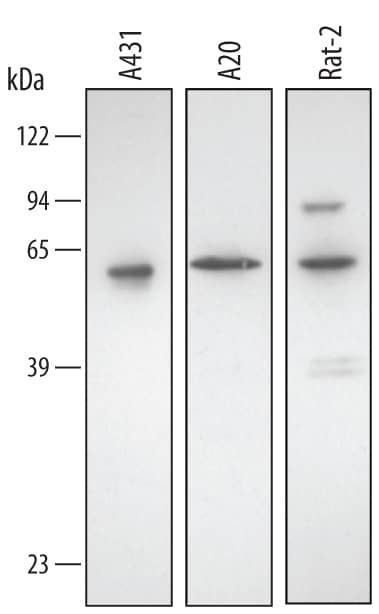Human/Mouse/Rat Annexin A11 Antibody
R&D Systems, part of Bio-Techne | Catalog # AF3927

Key Product Details
Species Reactivity
Applications
Label
Antibody Source
Product Specifications
Immunogen
Met1-Asp505
Accession # P50995
Specificity
Clonality
Host
Isotype
Scientific Data Images for Human/Mouse/Rat Annexin A11 Antibody
Detection of Human/Mouse/Rat Annexin A11 by Western Blot.
Western blot shows lysates of A431 human epithelial carcinoma cell line, A20 mouse B cell lymphoma cell line, and Rat-2 rat embryonic fibroblast cell line. PVDF membrane was probed with 1 µg/mL of Human/Mouse/Rat Annexin A11 Antigen Affinity-purified Polyclonal Antibody (Catalog # AF3927) followed by HRP-conjugated Anti-Goat IgG Secondary Antibody (Catalog # HAF017). A specific band was detected for Annexin A11 at approximately 56 kDa (as indicated). This experiment was conducted under reducing conditions and using Immunoblot Buffer Group 2.Detection of Human Annexin A11 by Simple WesternTM.
Simple Western shows lysates of Exosome Standards (LNCaP) (NBP3-11687), Exosome Standards (PC-3) (NBP2-49856) and A431 human epithelial carcinoma cell line, loaded at 0.5 mg/ml. A specific band was detected for Annexin A11 at approximately 59 kDa (as indicated) using 50 µg/mL of Goat Anti-Human/Mouse/Rat Annexin A11 Antigen Affinity-purified Polyclonal Antibody (Catalog # AF3927). This experiment was conducted under reducing conditions and using the 12-230kDa separation system.Applications for Human/Mouse/Rat Annexin A11 Antibody
Simple Western
Sample: Exosome Standards (LNCaP) (Catalog # NBP3-11687), Exosome Standards (PC-3) (Catalog # NBP2-49856) and A431 human epithelial carcinoma cell line
Western Blot
Sample: A431 human epithelial carcinoma cell line, A20 mouse B cell lymphoma cell line, and Rat-2 rat embryonic fibroblast cell line
Formulation, Preparation, and Storage
Purification
Reconstitution
Formulation
*Small pack size (-SP) is supplied either lyophilized or as a 0.2 µm filtered solution in PBS.
Shipping
Stability & Storage
- 12 months from date of receipt, -20 to -70 °C as supplied.
- 1 month, 2 to 8 °C under sterile conditions after reconstitution.
- 6 months, -20 to -70 °C under sterile conditions after reconstitution.
Background: Annexin A11
Annexin A11 (ANXA11), also known as Annexin XI, 56K Autoantigen and Calcyclin-associated annexin 50 (CAP50), is a 54.4 kDa (predicted) member of the Annexin protein family. The Annexins are a family of Calcium-dependent phospholipid-binding proteins that are preferentially located on the cytosolic face of the plasma membrane. The Annexin’s have a molecular weight of approximately 35‑40 kDa and consist of a unique amino terminal domain followed by a homologous C-terminal core domain containing the calcium-dependent phospholipid-binding sites. The C‑terminal domain is comprised of four 60‑70 amino acid (aa) repeats, known as annexin repeats or an endonexin fold (Annexin A6 contains 8 annexin repeats). The four annexin repeats form a highly alpha-helical, tightly packed disc known as the annexin domain, which binds to phospholipids in the membrane in a calcium-dependent manner. Members of the annexin family play a role in cytoskeletal interactions, phospholipase inhibition, regulation of cellular growth, and intracellular signal transduction pathways. Annexin A11 was identified as a 56 kDa antigen recognized by sera from patients with autoimmune diseases such as rheumatoid arthritis, systemic lupus erythematosus, or Sjogren's syndrome. Human Annexin A11 shares 93% identity with mouse and rat Annexin A11.
Alternate Names
Gene Symbol
UniProt
Additional Annexin A11 Products
Product Documents for Human/Mouse/Rat Annexin A11 Antibody
Product Specific Notices for Human/Mouse/Rat Annexin A11 Antibody
For research use only

